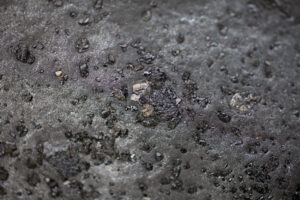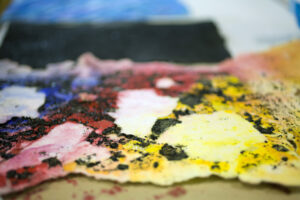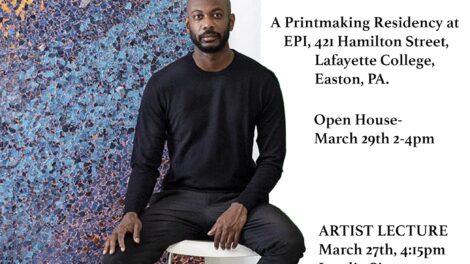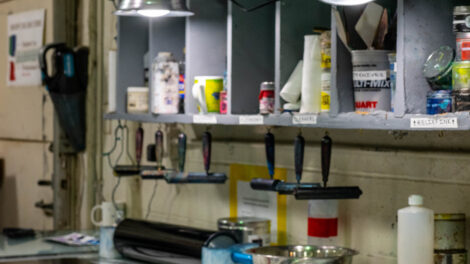ALTERONCE GUMBY: ARTIST RESIDENCY AT EPI
BY EMMA SYLVESTER
Alteronce Gumby will begin his Artist Residency this week as part of the Experimental Printmaking Institute’s Artist Residency Program. Through funding from the R.K. Laros Foundation and Curley Raven Holton Endowment Fund for the Arts, the program fosters a collaborative approach to printmaking, allowing students to directly observe a professional artist’s innovative approach to making while also being hands-on during the process.
Students in Assistant Professor Pedro Barbeito’s Interdisciplinary Printmaking class (ART212) will have the opportunity to work with Gumby from March 25-29, experimenting with the artist’s studio techniques to collaborate on a cohesive project.
Barbeito, who is also the director of EPI, shared that the collaborative process
will benefit Alteronce as the students can provide suggestions and technical expertise on what he can make and it will also help the students as they will be able to experience how Alteronce thinks through his work.
Gumby holds a B.F.A. from Hunter College, along with an M.F.A. in painting and printmaking from Yale University.
“Even though I lean more towards the painting aspect of the degree, I think it’s nice to come back here and have a moment back in the printshop,” Gumby said. “I’m a painter, and so I usually approach everything from a painter’s aesthetic…I use a lot of alternative mediums, like glass and gemstones, but also acrylic paint.”
The students have already spent a few weeks familiarizing themselves with these unique materials that are central to Gumby’s art in preparation for the collaboration.
Gumby explained that he incorporates gemstones and different techniques into his paintings to “create this synergy of experience where one can look at the painting and not just experience it visually, but also physically and conceptually.”
“I feel like I am really thinking about the experience one has when they’re looking at the painting, and what story and experience a viewer can have from engaging with the materials of the painting,” he said.
The history of pigments was what originally inspired Gumby’s exploration of color and tactile components.

close-up – artist work at EPI | Photo credit Aviv Springer-Galst
“The gemstones really came to me when I was thinking about where colors come from, or where pigments come from,” he said. “Because my work is mainly based on redefining color for myself, I wanted to go to the source of where color comes from, so I really started looking to nature…Doing a little bit of research, I realized that a lot of the materials we use as pigments come from the natural Earth, like red jasper or lapis lazuli, or ochre. Even some organic or plant materials like indigo and marigolds and cochineal.”
He first began to explore how dry pigments from plants could be turned into wet mediums and then expanded the scope of his interests in nature to discover how color functions in crystals.
“I started going to the gem store and looking at crystals and things like that, and was really just fascinated by the natural formation of these gems and the colors in which they give off,” Gumby said. “And so I just started having them around my studio. Eventually, I started embedding them into my painting.”
Gumby was also inspired by techniques used by other artists like William de Kooning, Sam Gilliam, Rashid Johnson, and Pierre Solonge, who incorporate elements of texture into their work to add depth with each brush stroke.
“I really wanted that aspect to my work as well, where you’re looking at the painting and there’s a physical resonance that’s happening as well,” he said. “We’re in the printshop, and I use a lot of printing techniques, but I feel like I’m also going to be bringing a lot of things outside the world of printmaking into this body of work.”
Ringing true to the interdisciplinary aspect of Barbeito’s course, Gumby will bring his experience in both painting and printmaking to the print shop for this particular project.
“Throughout my career, I feel like I have defined myself as a painter, more recently as more of just an artist, and I guess in my own way redefining what a painting is,” he said. “So while I’m here I’ll probably be looking to do the same, just redefine what a print is.”
The beautiful thing about [EPI] is that there’s a lot of different tools, and there’s a lot of different ways to experiment,…
Gumby said. “[Barbeito] has equipped the studio with a lot of equipment that allows students and artists to really think outside the box, and to bring tools that you might only see in like an engineering shop into the print studio to make new tools and formats for making a painting. So I think while I’m here, there’s a lot of equipment here and processes that I’m going to be experimenting with to bring things together.”
Barbeito is prepared to use the 100-ton hydraulic press for this collaboration to press crystals into paper pulp, with inks and some other materials. The paper being used for this project is ¼” thick and was hand-made at EPI in preparation for Gumby’s residency.
Gumby plans to enter EPI’s print shop with an open mind.
“My preliminary plan is to activate my imagination and then see what comes of that,” he said. “It’s really just playing around and seeing what happens…It’ll be a sharing of the minds.”

close-up 2 – artist work at EPI | Photo credit Aviv Springer-Galst
Gumby will have full access to the tools and equipment at EPI to explore the process and develop an idea for the work during his residency. While only on campus for his week-long residency, he hopes to get as much done as possible before leaving the project in the hands of the students.
“The work continues even after I leave,” he said. “We’ll get as far as we can get in terms of getting an idea and a process down while I’m here, and then it’ll be up to the students in the print shop to carry it over the finish line.”
I think it’s always great to have the opportunity to work with students because everyone is still learning, and still trying to figure things out, and that’s the type of energy I like to keep within my practice,” Gumby added.
I think you get a sense of play as an artist who’s been out in the field for a while and then to come back to school, I feel like the students are really just exploring and experimenting, and I kind of feed off that energy.
Gumby is joining the college from New York, where he has lived for 17 years, though originally from Harrisburg. “It’s good to be back in Pennsylvania,” he said. “It brings back fond memories to be back in the print shop, and I’m happy to be here at Lafayette.”



